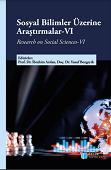Sayısallaştırılmış SWOT Analizi: Bulanık Analitik Hiyerarşi Prosesi Uygulaması
Quantitative SWOT Analysis: Application of Fuzzy Analytic Hierarchy Process
Author(s): Nadire Yapar Üstünol, V. Alpagut Yavuz
Subject(s): Business Economy / Management, Management and complex organizations
Published by: Özgür Yayın Dağıtım Ltd. Şti.
Keywords: businesses; competitive environment; management process; organizations;
Summary/Abstract: Nowadays, it is becoming increasingly difficult for businesses to sustain their existence in an increasingly competitive environment. In this case, organizations that can determine their strategic goals and plan their actions according to changing environmental conditions can only ensure their sustainability. In the strategic management process, organizations are considered as a whole and the goals of the sub-units that make up the organization must be compatible, coordinated and supportive with the goals of the organization. This approach suppresses the self-optimization motive in sub-units and emphasizes harmony among sub-units for the optimization of the whole organization. In order to increase the effectiveness of this process, quantitative SWOT analysis, one of the basic tools of strategic management, was employed in this study. With the application study, it has been shown that it is possible to effectively use internal and external factors that will affect the future of the organization in the decision-making process in SWOT analysis. In addition, by applying the method in the furniture sector in Antakya district of Hatay province, it is aimed to contribute to the decision-making process by determining the priority ranking of the proposed projects in order to take an effective position in the increasing competitive environment. In this study, Fuzzy AHP and Hesitant Fuzzy AHP methods were used to take into account the uncertainty and indecision in expert evaluations. In the analysis, SWOT factors were quantified according to the two methods and the proposed projects were associated with SWOT factors and their priority ranks were determined according to the two methods. As a result, when the two methods were compared, it was determined that the ranking obtained was consistent.
Book: Sosyal Bilimler Üzerine Araştırmalar - VI
- Page Range: 135-170
- Page Count: 36
- Publication Year: 2023
- Language: Turkish
- Content File-PDF

